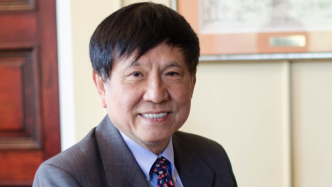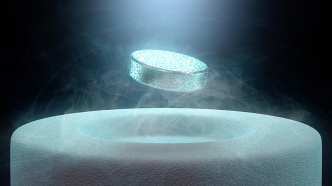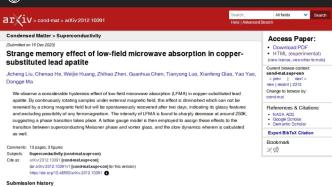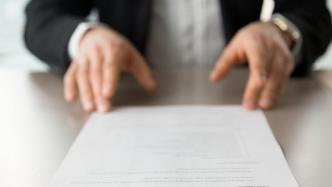
Research on room-temperature superconductivity in South Korea is sparking world frenzy, overshadowing research by Ranga Dias at the University of Rochester in March this year.
Many institutions at home and abroad have taken action to reproduce or demonstrate Korean research. Among them, two preprinted articles from the Institute of Metal Research, Chinese Academy of Sciences and the Lawrence Berkeley National Laboratory of the United States performed theoretical calculations. They found that LK-99 has the possibility of room temperature superconductivity or has some superconducting characteristics. The research paper of the School of Materials Science and Engineering of Beihang University found that the resistance of the synthesized LK-99 was not zero, and there was no magnetic levitation.
Netizens on station B also released experiments or videos to fuel the flames. Chang Haixin’s team from the School of Materials Science and Technology of Huazhong University of Science and Technology even released experimental videos on station B, claiming to reproduce the levitation experiment in Korea.
There's no shortage of cool voices present, either. Some netizens pointed out that whether it is the original Korean author or the popular video of Huazhong University of Science and Technology, it can only show that the material is diamagnetic, but it cannot prove that it is completely diamagnetic, because as long as the electromagnetic interaction force is greater than the gravity of the material itself, it can suspended. At the same time, the Lawrence Berkeley National Laboratory paper is merely computational work and cannot replace experimental research.
In addition, some voices pointed out that the Korean author's institution and the statement of the thesis are quite "civil science", which undoubtedly reduces the credibility of his research.
What do you think of people raving about this research? How reliable is this superconductivity research in South Korea? To what extent can their experiments prove superconductivity in their material?
In this regard, "Chinese Journal of Science" interviewed Professor Mao Heguang, director of the Beijing High Pressure Science Research Center. In 1989, he won the Bridgman Award, the highest award in the international high-voltage field. He was elected as an academician of the National Academy of Sciences in 1993 and a foreign academician of the Chinese Academy of Sciences in 1996. person in charge.

Professor Mao Heguang, Director of Beijing High Voltage Science Research Center.
"China Science Daily": Have you read these two Korean papers?
Mao Heguang: There are often news about superconductivity, but most of the news depends on who did it, how far he has achieved it, and how much foundation there is for this research.
The Korean study doesn't look very good. Even if we do it ourselves, we can't do it as fast as others, so I am also an audience, but it seems that their chances of success are slim.
"China Science Daily": You can't conclude that it is superconducting just by watching the video, right?
Mao Heguang: The material in their video will be partially suspended, which is a very common diamagnetic phenomenon of magnets. In terms of superconductivity, the antimagnetic force is very strong, and it can levitate trains and the like.
In fact, one ten-thousandth of the diamagnetism is enough to suspend a small piece of material. There are many materials and phenomena, unlike superconductivity. So if it is such a material in the end, it is not worth pursuing.
"China Science Daily": The research in Korea seems simple, but the whole world is paying attention to this matter, which is very interesting. Do you think it is not worth it?
Mao Heguang: This is different from Dias’s research, because his research was published in the journal Nature. Even if there are problems, it is at least worth repeating. We repeat and see a similar phenomenon, but strictly not superconducting.
The South Korean research may be a reference to the popularity of Dias. Their work was reported as early as 1999, and now it has been hyped up again. At this time, no matter whether others support or oppose it, they can be hyped up.
"Chinese Journal of Science": Is it possible that the Korean research will be successful?
Mao Heguang: Anything is possible, even if it is one in a million or one in ten million, but you can’t think that this material has any possible characteristics, it is really possible, otherwise it is like buying a lottery ticket Well, at least for now here in South Korea, it has not been shown to be scientifically reliable.
"China Science Daily": This research is theoretically possible, right?
Mao Heguang: Recently, the Lawrence Berkeley National Laboratory in the United States has a theoretical calculation saying that it is feasible. However, in theory, many materials may be calculated and feasible based on specific assumptions, but it does not mean that it is really feasible.
So experiment. As for the experiment, the first thing to look at is whether the person doing the experiment is reliable or not. If it is a person who has not received strict training in this area, you cannot trust him even if he publishes an article, because you do not know whether his article is reliable or not.
Second, scientists cannot cheat. Dias has this problem, that is, he has faked and retracted several times in the past, so even if his article seems very reliable, you still have to doubt it.
Third, you want to publish your article in a reliable journal. Why do you want to do this? It doesn’t mean that you can post a random journal or video, because the journal at least has a reviewer who has verified whether the author and the research are reliable, so even if there is a one-thousandth possibility, it is still worth following up.
If it is not published in such a journal, the reliability will be much weaker. Whether it's a few percent chance or how beautiful the video looks, after all magic tricks can produce beautiful visual effects.

Mao Heguang conducted a high-pressure diamond anvil experiment at the synchrotron radiation facility of the Argonne National Laboratory in the United States.
"China Science Daily": When Dias published his superconducting research in March, scholars including Zhu Jingwu said that he would repeat and verify it, but when South Korea published superconducting research, industry experts seemed not very enthusiastic. You should not repeat the Korean experiment, will you?
Mao Heguang: I will not repeat this experiment. But we repeated the Dias experiment, and it proved to be wrong.
Dias's research is possible because high-pressure room-temperature superconductivity has been proven, and several domestic laboratories have also produced high-temperature superconductivity at hundreds of GPa. This is an existing fact.
Diaz’s research in March used 1 GPa, which is a very low pressure, although it is also high pressure for the natural environment, so this can be repeated. Although Dias has a history of retraction, his work starts from a credible place and is based on the formal research steps advocated by science, but there are some things in the middle that he did not make clear, so it is worth verifying.
Korean studies have been a bit like civil science, or like magic from the beginning. You may have played with magnets. Antimagnetic materials will float when placed on a magnet. This material in Korea cannot be completely suspended. In fact, even if it is completely suspended, it is not necessarily superconducting. Only when the magnetic permeability drops to zero and the magnetic susceptibility is negative. 1 is superconducting, if the magnetic susceptibility is negative 0.0001, this is a small diamagnetic, but enough to lift it up.
"China Science Daily": Some people also say that many major breakthroughs in the field of superconductivity are actually made by laymen. Then there is a principle that people who do theoretical physics should not be trusted, and they should do experiments. If you practice like that, it is possible to succeed.
Mao Heguang: This is true. The final breakthrough in any field may not necessarily be a master in the field, but at least it must have professional knowledge. I also saw that many people on the Internet say that experts are not credible, which is an anti-intellectual idea. In fact, compared with ordinary people, experts are the accumulation of scientific knowledge. Experts must do something according to certain rules, but the important breakthrough is actually the expert who does not fully believe in the existing theory, and then he creates variables from this theory.
If you don't trust experts, "two bombs and one satellite" will not be possible. The so-called expert is to accumulate previous knowledge and go beyond and break through on this basis, but your previous knowledge is still necessary, rather than giving up all and returning to the original point.
"China Science Daily": Can it be understood in this way that superconductivity may not need to go so "far" in the first place, and then South Korea can directly burn a pot to refine it. Maybe it's a superconducting shortcut, a faster way.
Mao Heguang: In 1987, Zhu Jingwu’s team discovered the high-temperature superconducting material yttrium-barium-copper-oxide. The knowledge of experts has changed from accumulation to qualitative change, and then published rigorous journal reports. Then everyone did it, and everyone made it, so that is the real one. The breakthrough is to overthrow the previous scientific understanding. But not everyone can make superconducting breakthroughs, the probability is extremely low.
If superconductivity is so easy to do, then we will not go to experts to do this in the future, but let everyone make steel by indigenous methods. The result must be that you will spend a lot more effort than the experts, and the probability of success is almost zero.
Even if Minke will succeed, the probability of success is only one in ten billion, and the success of Minke is also an independent thing, there is no connection between them, and they are not cumulative.
This scientific system is useful. If you really want to break through, you need to find some breakthrough points in the system. Even though it does look a bit like an anti-system, you still need a scientific foundation.
After this is made in South Korea, there must be many people doing it now, it depends on who is quick. Diaz's research is different. There are only dozens of laboratories in China that can conduct 1GPa high-temperature superconductivity experiments.
Korean research is too easy to replicate, and there may be 1,000 laboratories in China that can do it. So this bullet can't fly, it will fall to the ground immediately, and you can see the truth and the false.
(The original title "Real breakthrough in South Korea's room-temperature superconductivity? "It's a bit like Minke from the beginning." The pictures in this article were provided by the interviewees.)


